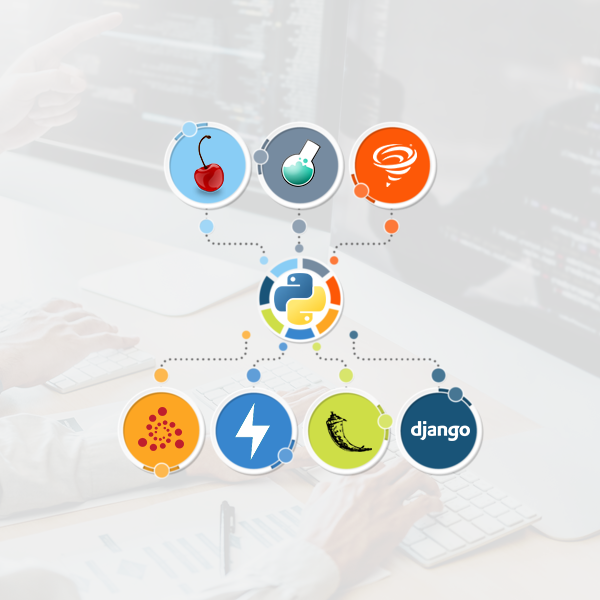Top 7 Python Frameworks Which One You Should Choose-Connect Infosoft
Python is often recognised as one of the most user-friendly programming languages available. Furthermore, various Python development frameworks are available, allowing developers to work on projects of varying complexity while using the language.
Python frameworks make your life easier by providing a structure for application development, automating the implementation of standard solutions, and saving development time dramatically. This allows you to concentrate on the application logic rather than wasting time and energy on unimportant routine pieces.
Here Are Seven Top Python Frameworks:
Django:
Django is a full-featured and high-level web framework that encourages rapid development and follows the "batteries-included" philosophy. It is excellent for building complex, database-driven web applications and is widely used for content management systems, social networks, and e-commerce platforms.
Pros Of Django
- High-level and full-featured.
- Rapid development with built-in features.
- Active and supportive community.
- Django REST Framework for APIs.
- Internationalization and localization support.
- Automatic admin interface for easy data management.
Cons Of Django
- Complexity for small projects.
- Tight coupling of integrated components.
- Customization needed for very large projects.
- Updates may require code adjustments.
- Less suitable for non-database applications.
Flask:
Flask is a lightweight and flexible micro-framework that provides only the essentials for building web applications. It is suitable for smaller projects and APIs and allows developers to add extensions based on their specific needs. Flask is known for its simplicity and ease of use.
Pros Of Flask
- Lightweight and simple design.
- Flexibility to choose tools and libraries.
- Minimal boilerplate code.
- Well-suited for building APIs.
- Seamless integration with the Python ecosystem.
- Highly testable applications.
Cons Of Flask
- Limited functionality compared to full-stack frameworks.
- Smaller learning curve but might not suit complex projects.
- Requires additional effort for security implementation.
- May face scalability challenges for large applications.
FastAPI:
FastAPI is a modern, high-performance web framework designed for building APIs quickly. It is built on top of Starlette and Pydantic, making it efficient and easy to use, with automatic data validation and documentation generation. FastAPI is well-suited for projects that require speed and scalability.
Pros Of FastAPI
- Fast performance.
- Automatic data validation.
- Rapid development process.
- Great for microservices.
- Active community and updates.
Cons Of FastAPI
- Less suitable for traditional web applications.
- Complexity and boilerplate in rapid development scenarios.
- Smaller community compared to some other frameworks.
- Asynchronous programming complexity for some developers.
- Possible upgrade compatibility issues.
Pyramid:
Pyramid is a versatile web framework that offers great flexibility and supports various project sizes and complexities. It is designed with a "pay only for what you need" approach, allowing developers to choose components and libraries according to their requirements.
Pros Of Pyramid
- High flexibility and adaptability.
- Easy integration of third-party libraries.
- Customizable to match project requirements.
- Broad compatibility with databases and servers.
- Extensive and well-maintained documentation.
Cons Of Pyramid
- More boilerplate code for complex applications.
- Less beginner-friendly compared to some other frameworks.
- Lack of some built-in tools found in other frameworks.
- Greater developer responsibility in making decisions.
- Complex URL mapping for large applications.
Tornado:
Tornado is an asynchronous networking library and web framework. It excels in handling long-lived connections and real-time applications like chat servers and IoT applications. If your project requires high concurrency, Tornado might be a good fit.
Pros Of Tornado
- High performance and efficiency.
- Suitable for high-traffic applications.
- Simple and lightweight design.
- Scalability for handling many connections.
- Support for both WebSocket and HTTP.
- Versatility for different application types.
Cons Of Tornado
- Less beginner-friendly for web development.
- Smaller community support.
- Compatibility issues with sync libraries.
- Potentially longer development time.
- Less suitable for CPU-bound tasks.
CherryPy:
CherryPy is a minimalistic web framework that focuses on simplicity and performance. It's a good choice for smaller projects and prototypes due to its ease of use and low overhead.
Pros Of CherryPy
- Built-in HTTP server for easy deployment.
- Customizable request handling and routing.
- Fast and efficient performance.
- Active and supportive community.
- Lightweight design for small to medium-sized applications.
Cons Of CherryPy
- Limited built-in features compared to full-stack frameworks.
- Learning curve for developers familiar with other frameworks.
- Smaller ecosystem with fewer third-party packages.
- May not suit all projects requiring extensive features.
- Development might not be as active.
Bottle:
Bottle is another lightweight micro-framework with a minimalistic design. It is suitable for small projects and APIs that need to be built with minimal code and dependencies.
Pros Of Bottle
- Simplicity and easy learning curve.
- Lightweight with fast performance.
- Single file applications for small projects.
- Built-in server for convenient testing.
- Extensible with plugins and middleware.
Cons Of Bottle
- Limited built-in features compared to full-stack frameworks.
- Less ideal for large and complex applications.
- Smaller ecosystem with fewer third-party packages.
- Not suitable for large teams collaborating on the same project.
- Limited template engine capabilities.
Conclusion:
The choice of framework depends on the specific needs and requirements of your project. If you're building a large-scale web application with many features, Django might be the best fit. For smaller projects or APIs with simplicity in mind, Flask or FastAPI could be more appropriate. For real-time applications and high concurrency, Tornado might be the way to go. Ultimately, it's essential to consider factors like project size, complexity, performance, scalability, and your team's familiarity with the framework before making a decision. Always check for updates and compare the latest features and community support for each framework before making your choice.
TAGS: Top 7 Python Frameworks Which One You Should Choose, Looking for Python Development Service in India, Connect Infosoft, Looking for Django Development Service in India, Hire Python Developers in India, Looking For Python Developer Team, Connect Infosoft Technologies


